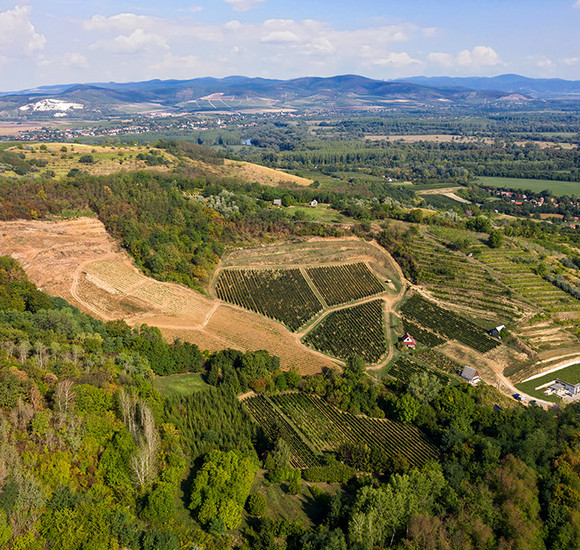Terroir
MARIASY
Tokaj - Hungary
The MARIASY vineyard is located in Tokaj, in the north-eastern part of Hungary, at the southern point of the volcanic Zemplén Mountains, on the side of the Kopasz Hill in Tokaj.
The town of Tokaj is the heart and jewel of the Hegyalja, the wine region, and the name of the protected geographical indication of origin: TOKAJI, in the old spelling TOKAY.

TOKAJ – CSURGÓ VALLEY – MÁRIÁS DŰLŐ
The Kopasz Hill in Tokaj is an 11 million-year-old volcanic formation with several former lava flows and loose debris flows, fed by two rivers, the Bodrog and the Tisza. The mass of Mount Kopasz is covered by the 250 000-year-old loess formation, which probably covered the whole mountain during the Pleistocene. Quartz is the main component of this light yellow sedimentary rock of wind-future origin. This granular soil, formed from this loess, also includes the bedrock of the Marias dune, varying in thickness from a few meters up to 20 meters.
The vineyard is of medium slope and has a south-southeast exposure. The high banks surrounding the production area provide considerable protection and a favourable microclimate for this small vineyard.
Grapes were already being grown here hundreds of years ago, as evidenced by the fact that the Máriás vineyard is included in the first Tokaj classification by SZIRMAY in 1789. Seeing and discovering the retaining wall system that emerged after the clearing of the scrubby woodland, built hundreds of years ago by hand with andesite rollers, and which towers over several levels, we bowed to the past, to our ancestors. The awe-inspiring terraces call for pause and contemplation, to continue only under the guidance of Ferenc Kazinczy's "good and well".



MÁRIÁS-DŰLŐ
As far as the history of the MÁRIÁS vineyard is concerned, we quote the work of Miles Lambert-GÓCS who, in his book TOKAJI WINE FAME, FATE, TRADITION A-Z through the history Tokaji wine, writes:
„Marias
This vineyard, located on the northern side of the Tokaj hill in Tokaj, was classified by Szirmay as Class 3 in 1789. Its name is reminiscent of the strangest misnomer in the history of Hegyalja, although it may have been intentional. It was also known as Máriássy, referring to a noble family from Sáros County. Because of this connection, it was probably the original name. But it was also known as Mariás (Marjás in older documents), as Szirmay referred to it in 1789. This term refers to the custom of providing seasonal workers with a daily meal and weak wine. This may have begun in the early 1700s, at the end of the 16th century, when there was a proliferation of owners from outside the Highland who had to lure workers from nearby villages...”
MARIASY
The revitalisation of the MARIASY vineyards and plantations began in 1996 with the purchase of a plot of land in the central part of the vineyard and its planting with Furmint grapes in 1999.
In 2017, we decided to acquire additional land, when Dr. Zsolt Szabó dynamized the construction of the estate, winery building architect plans and then landscape architect plans were made, Furmint vine planting began, MARIASY BIRTOK took shape.
The MEDIVIN PRO WINE TREASURY LTD. is organized to run the estate and in joint work, life paths meet. The life cycle of the vine has set a rhythm, has defined our thinking and our lives.

THE WINERY – AN EXCITING BLEND OF TRADITION AND MODERNITY
We built the MARIASY Winery in the Csurgó-Valley of Tokaj, in the Máriás vineyard, next to the former andesite quarry. Here, a human scale and an easy-to-understand building form ensure every step of the winemaking process. The complex of modern grape processing, fermentation and aging buildings in three naves fits well within the centuries-old terraces and steep loess walls.
The winery building is reminiscent of traditional winery buildings: a building that rhymes with cellar doors that emerge from the ground disappears underground. The floating canopy folds up the green hillside behind it, revealing the technology that lurks beneath. Its façade does not want to appear to be more than it is: the three entrances conceal a farm building. Its austere solidity is further enhanced by the stone cladding, which is only broken up by the glass wall of the tasting room. Behind the building, a system of retaining walls, planted with orchards and vines, continues organically into the interior. The fourfold system of office - harvesting - fermentation - storage defines the simple design of the building, which is designed to serve the technology to the maximum.
The winery, which is set in a landscape of around 400 square meters, has all the tools for modern winemaking: a sorting table, a gentle pneumatic press, refrigerated stainless fermentation and storage tanks. The aging barrels are made of Zemplén and French oak and are housed in a separate cellar section, similar to the bottle-matured wines, where a controlled air space ensures the wine aging process.




